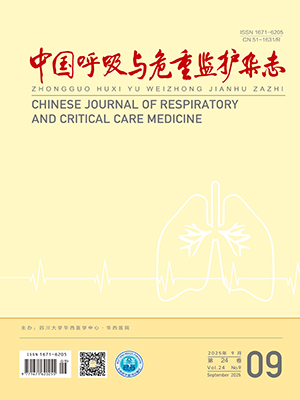| 1. |
Goeminne P, Dupont L. Non cystic fibrosis bronchiectasis: diagnosis and management in 21st century. Postgrad Med J, 2010, 86(1018): 493-501.
|
| 2. |
段承祥, 潘纪戍, 张火俊. 支气管扩张症. 胸部疾病影像鉴别诊断. 北京: 中国协和医科大学出版社, 2010, 56-79.
|
| 3. |
Reiff DB, Wells AU, Carr DH, et al. CT findings in bronchiectasis: limited value in distinguishing between idiopathic and specific types. Am J Roentgenol, 1995, 165(2): 261-267.
|
| 4. |
成人支气管扩张症诊治专家共识编写组. 成人支气管扩张诊治专家共识. 中华结核和呼吸杂志, 2012, 35(7): 485-492.
|
| 5. |
Kelly MG, Murphy S, Elborn JS, et al. Bronchiectasis in secondary care: a comprehensive profile of a neglected disease. Eur J Intern Med, 2003, 14(8): 488-492.
|
| 6. |
Loebinger MR, Wells AU, Hansell DM, et al. Mortality in bronchiectasis a longterm study assessing the factors influencing survival. Eur Respir J, 2009, 34(4): 843-849.
|
| 7. |
Seitz AE, Oliver KN, Steiner CA, et al. Trends and burden of bronchiectasis associated hospitalizations in the United States, 1993-2006. Chest, 2010, 138(4): 944-949.
|
| 8. |
宋杰, 刘保清, 王金祥, 等. 493 例支气管扩张急性感染的细菌特点及药敏分析. 临床肺科杂志, 2012, 17(7): 1212-1214.
|
| 9. |
蔺雪, 许西琳, 张红梅. 支气管扩张症稳定期下呼吸道细菌定植的研究. 中国实用医刊, 2014, 15: 28-29.
|
| 10. |
Cole PJ. Inflammation: a two-edged sword--the model of bronchiectasis. Eur J Respir Dis Suppl, 1986, 147: 6-15.
|
| 11. |
King PT, Holdsworth SR, Freezer NJ, et al. Characterisation of the onset and presenting clinical features of adult bronchiectasis. Respir Med, 2006, 100(12): 2183-2189.
|
| 12. |
Polverino E, Goeminne PC, McDonnell MJ, et al. European Respiratory Society guidelines for the management of adult brochiecasis. Eur Respir J, 2017, 50(3): 1700629.
|
| 13. |
Finch S, McDonell MJ, Abo-Leary H, et al. A comprehensive analysis of the impact of Pesudomonas aeruginosa colonization on prognosis in adult bronchiectasis. Ann Am Thorac Soc, 2015, 12(11): 1602-1611.
|
| 14. |
Pasteur MC, Bilton D, Hill AT. British thoracic society bronchiectasis non-CF guideline group. British thoracic society guideline for non-CF bronchiectasis. Chest, 2010, 65 Suppl 1: i1-i58.
|
| 15. |
Chalmers JD, Goeminne P, Aliberti S, et al. The bronchiectasis severity index. An international derivation and validation study. Am J Respir Crit Care Med, 2014, 189(5): 576-585.
|
| 16. |
Oliveira MJ, Vaz D, Coutinho D, et al. Morbidity and risk factors for mortality in patients with acute exacerbation of bronchiectasis. Chest, 2014, 145(3): 430A-1-430A-2.
|
| 17. |
Orriols R, Hernando R, Ferrer A, et al. Eradication therapy against Pesudomonas aeruginosa in non-cystic fibrosis bronchiectasis. Respiration, 2015, 90(4): 299-305.
|
| 18. |
White L, Mirrani G, Grover M, et al. Outcomes of Pseudoonas eradication therapy in patients with non-cystic fibrosis bronchiectasis. Respir Med, 2015, 106(3): 356-360.
|
| 19. |
焦瑞, 刘双. 支气管扩张急性加重的危险因素及意义. 中华医学杂志, 2015, 195(4): 272-276.
|
| 20. |
Mao B, Lu HW, Li MH, et al. The existence of bronchiectasis predicts worse prognosis in patients with COPD. Sci Rep, 2015, 5: 10961.
|
| 21. |
Martinez-Garcia MA, Soler-Cataluna JJ, Donat Sanz Y, et al. Factors associated with bronchiectasis in patients with COPD. Chest, 2011, 140(5): 1130-1137.
|
| 22. |
Onen ZP, Gulbay BE, Sen E, et al. Analysis of the factors related in mortality in patients with bronchiectasis. Respir Med, 2007, 101(7): 1390-1397.
|




